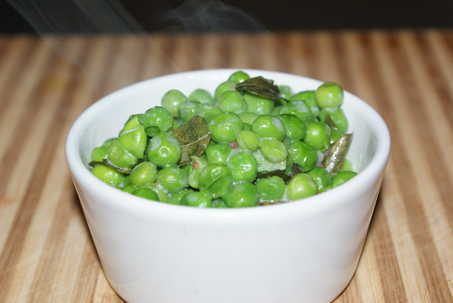
101 Uses for Leftover Yoghurt Sauce

Well, 2 uses for leftover yoghurt sauce at least.
Every so often I'm overcome with a nostalgic desire to get absolutely pissed and furiously consume one of the frozen Spicey Cottage Curries (Karahi Gosht - extra spic"e"y) that my Mum brings up for me from her (and once my) local curry shop.
It's a complicated ritual that involves laying in a stock of Marston's Strong Pale Ale (a fine brew which is both delicious and reasonably priced, not to mention 6.2% ABV, which possibly explains why they seem to no longer make it, the nannyist bollocks), making up a nice soothing pot of yoghurt sauce and running a bubbling foam bath in preparation for the evening's entertainment. This may seem a lot of effort, but it does have the benefit of cutting out the tedious need to spend the night pub-crawling through Wibsey trying to get loaded enough to really enjoy the curry at its source.
First I stick a few starter beers in the freezer, make up a vat of the yoghurt sauce du jour (they're all a bit random as to quantities and precise ingredients, but it's hard to go wrong), then I roll out the seeds from a half-dozen or two thin green chillies and slice them over the top of the frozen curry, put the lid back on the tin-foil container and pop it into the oven on its lowest setting. Then it's into the bath with some bubbles, the first beer and Radio4 Extra for company.
Luxury.
The curry is ready to eat when the mouth-watering smell of it fills the house, and you can't resist its call any longer.
Or you regain consciousness in a cold bath. Whichever comes first.
Usually I end up having to make too much yoghurt sauce for just the one meal, it being too hard to grind up fewer ingredients, so I have to think of things to do with the leftover.
Obviously I can make up more curries to eat with it, but it also makes a reasonable topping for a spicy soup if you happen to have a bunch of vegetables that need boiling hanging around and some trahana to bolster them with.
This time I thought I'd see what it's like as a marinade, so I poured the leftover sauce with a bit of extra garlic over a couple of pork chops and stuck them in the fridge for a day. I made up a quick curry with some frozen peas, a small pot of rice, and stuck the chops under the grill. Shake off excess sauce first - or it'll just burn.
To be honest the sauce isn't really rich or complex enough to impart all that much flavour to the pork, even if it does a reasonable job of tenderising the meat though it takes a day or two. Of course you can always add spices to boost its potency.
The peas were better than the pork :)
I used the rest of the sauce to whip up an Aloo Dom adding a bit of extra grated ginger root to fry up with the coated, par-boiled potatoes in a generous amount of oil to give some extra crispiness before adding the sauce (as was - except for a bit of extra salt and the obligatory extra chillies) and simmering until tender.
That worked pretty well.
Of course, now I've got leftover curries from the leftover sauce, which I need to make more curries to eat with, like this delicious achar gosht or these not-quite-so-successfull tandoori aubergines, and before you know it I've returned to the days of endless curries and the terrifying cycle repeats.
Coconut Pea Curry
curry side veg
Pea curry with coconut and curry leaves.
A quick and clean pea curry - that doesn't adulterate their freshness overmuch.
Serves 4
Ingredients
- ghee or oil
- generous ½ teaspoon black mustard seeds
- generous ½ teaspoon yellow mustard seeds
- 1lb/500g fresh or frozen peas
- half-dozen spring onions
- pinch or three of dried curry leaves
- 2 tablespoons coconut powder or coconut cream
- ½ teaspoon salt
- a little water
Throw the curry leaves into a little boiling water to soften.
Dissolve the coconut powder in a half cup of water (mixing the water into the powder gradually) if using.
Chop the spring onions.
Heat the ghee or oil and fry the mustard seeds until they start to pop.
If you're using fresh peas throw the spring onions into the pot, quickly followed by the peas. If you're using frozen peas, just add them straight away and throw in the spring onions on top.
Stir in the coconut, salt, and the soaked curry leaves with their water.
Seal tightly and simmer gently for 5-10 minutes until the peas are cooked and the curry leaves softened.
Serve dressed with a little mustard oil.
Dissolve the coconut powder in a half cup of water (mixing the water into the powder gradually) if using.
Chop the spring onions.
Heat the ghee or oil and fry the mustard seeds until they start to pop.
If you're using fresh peas throw the spring onions into the pot, quickly followed by the peas. If you're using frozen peas, just add them straight away and throw in the spring onions on top.
Stir in the coconut, salt, and the soaked curry leaves with their water.
Seal tightly and simmer gently for 5-10 minutes until the peas are cooked and the curry leaves softened.
Serve dressed with a little mustard oil.
Achar Gosht
Lamb and Pickle Curry
Lamb and Pickle Curry
curry main meat
I've always liked this in the restaurants, but this is the first time I've had a go at making it.
It's surprisingly simple. If your lamb is very lean you won't need to pre-fry it at all - I just do that to render any fatty pieces.
Serves 4
Ingredients
- ghee
- 2 medium onions
- half dozen garlic cloves
- couple inches root ginger
- chilli powder to taste
- 1 teaspoon salt
- 2 tablespoons curry powder
- 1-2 tablespoons vinegar I used sherry vinegar
- couple tablespoons tomato purée
- 1 aubergine cut into 1½" cubes
- 1½ lb lamb, cut into 1½" cubes
- 2-4 tablespoons lime or aubergine pickle, roughly chopped
- 1 mango
- a few tablespoons chopped fresh coriander leaves
preheat the oven to 375°F/190°C/Gas 5.
Purée the onion, garlic and ginger root together. Add a little water if necessary.
Cut the aubergine and lamb into decent chunks: 1"-2" cubes.
Mix the powders with enough vinegar to make a thick paste. I added half a teaspoon of chilli powder and also a teaspoon each of ground coriander, cumin and turmeric to freshen the curry powder. .
Heat a heavy casserole and lay in any fatty cubes of lamb, fat side down. Allow the fat to crisp up without drying out the meat, then scoop out the cubes with a slotted spoon and set aside with any uncooked lean cubes.
Add plenty of ghee to the pot and gently fry the purée until the bitter smell has gone and the oil begins to separate.
Add the spice paste and fry until the harsh smell has gone and the oil separates again.
Add the tomato purée and fry until the oil separates again.
Stir in the lamb to coat well, then add the aubergine. Add a couple of tablespoons of the pickle, roughly chopped. If you use aubergine (brinjal) pickle you can probably add more, but hot lime pickle is quite strong. Heat through, put on the lid and stick the casserole in the oven.
Cut the mango into 1" cubes and chop the coriander leaves.
After 20 minutes take out the casserole, stir and taste. Add more pickle if you like, and a little stock if it seems too dry, not too much though - you want it dry.
Put back in the oven and cook for another 20-30 minutes until the lamb is tender.
Stir in the mango and coriander, put the casserole back in the oven and turn it off. Leave for 10-15 minutes for the flavours to mature.
Serve with pooris or rice and a minty yoghurt sauce.
Purée the onion, garlic and ginger root together. Add a little water if necessary.
Cut the aubergine and lamb into decent chunks: 1"-2" cubes.
Mix the powders with enough vinegar to make a thick paste. I added half a teaspoon of chilli powder and also a teaspoon each of ground coriander, cumin and turmeric to freshen the curry powder. .
Heat a heavy casserole and lay in any fatty cubes of lamb, fat side down. Allow the fat to crisp up without drying out the meat, then scoop out the cubes with a slotted spoon and set aside with any uncooked lean cubes.
Add plenty of ghee to the pot and gently fry the purée until the bitter smell has gone and the oil begins to separate.
Add the spice paste and fry until the harsh smell has gone and the oil separates again.
Add the tomato purée and fry until the oil separates again.
Stir in the lamb to coat well, then add the aubergine. Add a couple of tablespoons of the pickle, roughly chopped. If you use aubergine (brinjal) pickle you can probably add more, but hot lime pickle is quite strong. Heat through, put on the lid and stick the casserole in the oven.
Cut the mango into 1" cubes and chop the coriander leaves.
After 20 minutes take out the casserole, stir and taste. Add more pickle if you like, and a little stock if it seems too dry, not too much though - you want it dry.
Put back in the oven and cook for another 20-30 minutes until the lamb is tender.
Stir in the mango and coriander, put the casserole back in the oven and turn it off. Leave for 10-15 minutes for the flavours to mature.
Serve with pooris or rice and a minty yoghurt sauce.
Bloody delicious!
Don't overdo the pickle - it can be a bit intense.
If you like you could fry some carrot chunks or cauliflower after the tomato purée or separately fry up some potato cubes and throw them in with the lamb too.
Don't overdo the pickle - it can be a bit intense.
If you like you could fry some carrot chunks or cauliflower after the tomato purée or separately fry up some potato cubes and throw them in with the lamb too.
I made this again without bothering to pre-fry my (pretty fatty) lamb shoulder cubes - and it was just as lovely.
I made the curry powder from grinding
I made the curry powder from grinding
- 1 tsp fenugreek seeds
- small stick cassia
- 4 cloves
- 2 tsps dried fenugreek leaves
- 2 tsps dried curry leaves
- 1 tsp cumin powder
- 1 tsp coriander powder
- 1 tsp turmeric
- 1 tsp mustard powder
- 1 tsp chilli powder
- 1 tsp ground black pepper
Tandoori Aubergine
curry side veg
I made this since I had some spare tandoori paste that needed using up, and was grinding up some onion, garlic ginger paste for another dish.
I doubt you would bother to grind up only a tablespoon otherwise.
I'm sure you could do the same thing with any other solid vegetable - cauliflower, courgette, potato, even onions
If you're going to skewer them you probably want hefty chunks of vegetable, rather than the slices below.
I'm sure you could do the same thing with any other solid vegetable - cauliflower, courgette, potato, even onions
If you're going to skewer them you probably want hefty chunks of vegetable, rather than the slices below.
Serves 4
Ingredients
- 2 aubergines
- 2-3 tablespoons tandoori paste
- 1 tablespoon yoghurt
- 1 tablespoon ground onion/garlic/ginger purée
Grind up your tablespoon of onion, garlic and ginger(!)
Slice the aubergines lengthwise about 1" thick, salt and leave in a colander to drain for 15 minutes or so.
Pat dry, rinsing off excess salt if necessary, then coat with the tandoori paste mixture and leave to marinate for a couple of hours.
Preheat the oven to moderately hot - Gas Mark 5/190°C. Lay in a single layer in an oven tray, or thread onto skewers, drizzle with a little oil, and bake until golden. Baste with oil occasionally.
Slice the aubergines lengthwise about 1" thick, salt and leave in a colander to drain for 15 minutes or so.
Pat dry, rinsing off excess salt if necessary, then coat with the tandoori paste mixture and leave to marinate for a couple of hours.
Preheat the oven to moderately hot - Gas Mark 5/190°C. Lay in a single layer in an oven tray, or thread onto skewers, drizzle with a little oil, and bake until golden. Baste with oil occasionally.
I baked mine layered in a Pyrex dish, and though they tasted good enough, they inside layers didn't crisp up at all,
but looked a bit soggy and vaguely green.
Mind you I did also rub my aubergines with mango powder and turmeric before smearing on the tandoori paste, which may not have helped: I was a bit short of tandoori paste.
Mind you I did also rub my aubergines with mango powder and turmeric before smearing on the tandoori paste, which may not have helped: I was a bit short of tandoori paste.
Tickling Seafood Allergies in Eyemouth

An overnight trip down the river in slim company to Eyemouth.
Possibly due to the complete failure of the yacht club, during the upheaval of the building of a new Forth crossing, to advertise the race, or maybe just part of the steady decline of sailing around these parts, for whatever reason this year's Convoy Cup race featured only two lonely entrants - ourselves and a Fisher Row Moody 27 Bilge Keeler called Sulumar.
As you can imagine - we fancied our chances for a prize, but sadly despite beating the competition by 1½ hours over the five hour race, we still lost by an hour on corrected time. Damn these handicappings are harsh!
Still we got to eat well on the way there!
Eyemouth has suffered for as long as I've been going there with having nowhere worthwhile to eat. Though the fish shop is perfectly adequate, the only other restaurant fish available seems to be frozen or breaded pap courtesy of Captain Birdseye, and I consider my meal at the local gastric pub "The Discontented Sole" to be amongst my most horrible dining experiences.
Fortunately these times are gone with the re-opening of the Churches Hotel and Seafood Restaurant under Lesley Orson and Lawson Wood, whose fishy skills we thoroughly tested whilst recovering from the race.
Or possibly from the GinAndTonics?
As dedicated followers of fashion will know I'm allergic to shellfish - have been ever since I stuck a prawn in my eye on the seafront at Leigh-On-Sea to impress my first proper girlfriend Louise and it blew up like a comedy eye balloon. So naturally I try to eat shellfish whenever I can, for one thing it's delicious, and for another I like to keep an eye on my reaction, so I'll know if it ever looks like ramping up and killing me. Provided it's only doing it pretty slowly, of course.
It's an odd thing actually - it doesn't happen with all shellfish and it doesn't seem to depend on how they're prepared. But the fresher they are the less they seem to affect me. Crustacae are the worst, mussels, scallops and squid give me just a little tickle, and oysters don't seem to affect me at all (touch mother-of-pearl).
So anyway, I couldn't resist the menu's Luxury crayfish and prawn cocktail. And luxury it was too. Hardly any life-threatening allergic reaction, a lovely rich creamy Marie Rose sauce (secret ingredient - mayonnaise!) and a delightful little salad dressed, as I was told, with a fragrant homemade herb oil. It took me ages to figure out where the occasional delicate bursts of basil were coming from!
If I have a complaint about the restaurant it's that they didn't have any tomato juice for my Bloody Mary. Bloody Hell!
Still I was suddenly struck with the idea of serving the Bloody Mary they didn't have in a giant beef tomato. With a straw sticking out. So struck in fact, that I had to make an immediate note in my brand new smartphone. Having recently lost my classic dumbphone I decided to finally bite the bullet and upgrade to the latest and greatest all-singing all-dancing smartassphone.
This modern technology is a white-knuckle ride people, and I'm still hanging on grimly. Ask me how it's going in a couple of years....
So, seeing as how my first course hadn't killed me, I had the scallops for my main. And such scallops I have never had. They tasted even fresher than ones I've cut open straight off a fishing boat, and these had been given just the merest hint of a scorching hot pan to give them a little caramelised glaze.
Beautiful. Though a bit skimpy if I'm honest - I was slightly jealous of the other dinners, but then I got to try them all anyway so that's alright then.
For dessert I chose the unlikely pairing of an undrinkably sweet, dark sherry called Pedro Ximénez (from the grape of the same name) and vanilla ice cream.
On it's own the wine tastes like alcoholic prune juice, though not alcoholic enough to be worth drinking, but paired with the ice cream there's an almost alchemical reaction which creates an inspired dish. Just pour the shot glass of sherry over the ice cream until balance is reached, then dig in.
And throw the rest of the sherry away!
Anyway, I liked the hotel so much that I bought the company. Well, OK, I just hired them out for my birthday party.
But to my bank account that's feeling like the same thing.
In an unrelated tickling I recently fed Flora some of Anthony Bourdain's Norman mussels (or molds as Google Translate unreliably informs me) which she ate with the gusto of two, huge blokes. That Bourdain - he may be a mercenary bastard and his food might be a bit rough around the edges, but he sure knows how to cook.
From his Les Halles cookbook
Anthony Bourdain's Moules Normandes
starter main fish
Mussels with Calvados
Must be served with a crusty white bread to soak up all the delicious juices.
Of which there are plenty!
Serves 4. Or 2 Floras
Ingredients
- ¼ pound (100g) slab bacon, cut into ½-inch/1-cm cubes
- 4 tablespoons (56g) butter
- 1 shallot, thinly sliced
- 6 small white mushrooms, thinly sliced
- ½ apple, cored, peeled, and cut into small dice or chunks
- 3 fl oz (75 ml) good Calvados
- glass of white wine or dry cider optional
- 1 cup (225 ml) heavy cream
- salt and pepper
- 6 pounds (2.7 kg) mussels, scrubbed and debearded (just before cooking)
In a small pot, cook the bacon over medium-high heat until the meat is brown and the fat has been rendered, about 10 minutes,
stirring occasionally to avoid sticking.
Scoop out the meat with a slotted spoon and reserve.
In a large pot, heat the butter with the bacon fat until it foams. Add the shallot and cook until soft, about 3 minutes.
Add the mushrooms and the apple and cook for 5 minutes.
Add the bacon and then stir in the Calvados, scraping the bottom of the pot with the wooden spoon to dislodge any good brown stuff that might be clinging there.
Add a splash of white wine, or cider if you like, and reduce a little.
Stir in the cream and season with salt and pepper.
Once the mixture has come to a boil, add the mussels and cover. Cook for 10 minutes, or until all of the mussels have opened. Shake. Cook for another minute. Shake again.
Serve immediately.
Scoop out the meat with a slotted spoon and reserve.
In a large pot, heat the butter with the bacon fat until it foams. Add the shallot and cook until soft, about 3 minutes.
Add the mushrooms and the apple and cook for 5 minutes.
Add the bacon and then stir in the Calvados, scraping the bottom of the pot with the wooden spoon to dislodge any good brown stuff that might be clinging there.
Add a splash of white wine, or cider if you like, and reduce a little.
Stir in the cream and season with salt and pepper.
Once the mixture has come to a boil, add the mussels and cover. Cook for 10 minutes, or until all of the mussels have opened. Shake. Cook for another minute. Shake again.
Serve immediately.
Veeeeery tasty!
Though there are quite a lot of bits in the sauce, which might be a presentational consideration.
If you want to go to a lot of effort you can quickly arrange the mussels spread open and standing upright in concentric circles in an enormous, shallow, heated serving dish starting from the outside and working them inwards and upwards. Finished by straining the (re-heated) sauce over them.
I didn't!
Though there are quite a lot of bits in the sauce, which might be a presentational consideration.
If you want to go to a lot of effort you can quickly arrange the mussels spread open and standing upright in concentric circles in an enormous, shallow, heated serving dish starting from the outside and working them inwards and upwards. Finished by straining the (re-heated) sauce over them.
I didn't!
Nautical Pork 'n' Beans
main meat nautical stew
A fairly rough and ready late-night feed for a hungry crew.
Of non-vegetarians.
Of non-vegetarians.
Serves 6
Ingredients
- 2 onions, finely sliced
- 2 tsp brown sugar
- about 15 medium-small potatoes
- 6 gammon steaks
- 1 tsp balsamic vinegar
- 2 Oxo cubes, dissolved in a little hot water
- couple shots whisky
- 1 tsp dried mixed herbs
- 1 tsp garlic granules
- 1 tablespoon HP sauce
- 2 tins beans
Get out your pressure cooker.
Slice the onions finely and gently caramelise with a couple of teaspoons of sugar in a generous amount of butter or oil until nicely golden.
Cut the pork into 1" or 2" chunks. Add to the onion and stir until well coated.
Scrub or peel the potatoes, cut into 1" or 2" pieces. Add to the pot and stir through.
Add a generous slug of whisky don't tell the skipper! and allow it to cook off a little, then add a teaspoon of balsamic vinegar, a tablespoon of brown sauce, some garlic granules, mixed herbs, 2 Oxo cubes dissolved in a little boiling water and 2 tins of beans.
Stir thoroughly, secure the pressure lid and warm until the pressure indicator pops out. Cook over a low heat for about half an hour giving it a good shake occasionally to stop things sticking.
Slice the onions finely and gently caramelise with a couple of teaspoons of sugar in a generous amount of butter or oil until nicely golden.
Cut the pork into 1" or 2" chunks. Add to the onion and stir until well coated.
Scrub or peel the potatoes, cut into 1" or 2" pieces. Add to the pot and stir through.
Add a generous slug of whisky don't tell the skipper! and allow it to cook off a little, then add a teaspoon of balsamic vinegar, a tablespoon of brown sauce, some garlic granules, mixed herbs, 2 Oxo cubes dissolved in a little boiling water and 2 tins of beans.
Stir thoroughly, secure the pressure lid and warm until the pressure indicator pops out. Cook over a low heat for about half an hour giving it a good shake occasionally to stop things sticking.
Pretty fine impromptu Pork 'n' Beans
Teriyaki Toffee Salmon
I usually try to plan my evening meals with Flora a few days in advance. I try, but I rarely succeed.
What usually happens is I end up wandering around my local Fucking Supermarket™ at lunchtime trying to put ingredients together in my head.
Sometimes it comes off and sometimes it doesn't.
Today Flora demanded noodles I thought I'd make some neat little bundles of pasta and a few other vegetables cut into noodle-like ribbons
(so we aren't just having noodles) by shaping them with ramekins.
So most of my wandering around the aisles was looking for noodly vegetables. I was thinking courgettes and apple, but then I noticed the Asian pears
Isn't that a bit racist? A racist fruit? and thought I'd give them a go.
I also had an idea that ribbons of sharon fruit (persimmons) might go nicely with carrot, but they didn't have any persimmons. Though they had some lemon grass. So I went with that.
The notion of caramelizing fish popped into my head while I was buying my lunchtime roll-mop herring. I fancifully imagined wrapping salmon pieces in a thin, teriyaki-flavoured, crispy shell, but the result was a lot more (very) sticky toffee than brittle crunch.
I wonder if a bit more experimenting, perhaps with making the coating thinner, cooking off more of the soy sauce from the caramel, coating the fish with something powdery to dry off the surface might produce better results?
Or the idea might just be doomed - I see that Heston makes a fishy shell based on Gellan (a polysaccharide gum), but I haven't been able to figure out how hard it is - I get the impression it's soft and springy like jelly.
I also had an idea that ribbons of sharon fruit (persimmons) might go nicely with carrot, but they didn't have any persimmons. Though they had some lemon grass. So I went with that.
The notion of caramelizing fish popped into my head while I was buying my lunchtime roll-mop herring. I fancifully imagined wrapping salmon pieces in a thin, teriyaki-flavoured, crispy shell, but the result was a lot more (very) sticky toffee than brittle crunch.
I wonder if a bit more experimenting, perhaps with making the coating thinner, cooking off more of the soy sauce from the caramel, coating the fish with something powdery to dry off the surface might produce better results?
Or the idea might just be doomed - I see that Heston makes a fishy shell based on Gellan (a polysaccharide gum), but I haven't been able to figure out how hard it is - I get the impression it's soft and springy like jelly.
Update:
Well, after a bit more experimenting, it's pretty obvious that this toffee coating is never going to be crisp while it's still hot. Or even warm. Even if the caramel sets like glass when it cools down.
Which is pretty much a bust when it comes to a crispy coating for hot fish, though I suppose it might fly for sushi!
Sigh - back to the drawing board!
Well, after a bit more experimenting, it's pretty obvious that this toffee coating is never going to be crisp while it's still hot. Or even warm. Even if the caramel sets like glass when it cools down.
Which is pretty much a bust when it comes to a crispy coating for hot fish, though I suppose it might fly for sushi!
Sigh - back to the drawing board!
Teriyaki Toffee Salmon
main side fish
Salmon in a Teriyaki caramel coating, served with ribbon courgettes, carrots, and pasta.
A (failed) attempt to coat pieces of salmon with a crispy teriyaki-flavoured shell, that was still a very tasty meal.
Serves 2
Ingredients
- 2 salmon fillets
- 4 prawns
- spring onions, shredded for garnish
- a few strips of lemon zest for garnish
For the pasta:- 1 egg
- 4 oz semolina
- grated peel of a lemon
- drizzle of oil
For the carrots:- 2 carrots
- juice of 2 satsumas
- 1 stick lemon grass, split
- knob of butter
- salt
For the courgettes:- 2 courgettes
- ½ Asian pear
- rice wine vinegar
- 1" piece ginger, thinly sliced or shredded
For the teriyaki:- ginger, julienned
- ¼ cup soy sauce
- ¼ mirin
- 1 tablespoon dark sugar
For the toffee:- 100g caster sugar
- 1 tsp glucose to prevent crystallization
- 1 tsp rice vinegar ditto
Turn your oven on low and put the plates in to warm.
Make up the pasta dough adding the grated lemon peel and leave to rest.
Make up the teriyaki sauce:
Simmer the soy sauce with an equal amount of mirin, 1/5 the volume of sugar and the ginger until it starts to thicken. Leave to cool and strain out the ginger.
Clean the salmon, removing any stray scales and bones and cutting into nice pieces.
De-shell and de-vein the prawns.
Use a peeler to cut thin strips of the courgettes and Asian pears.
Set aside the pears in a little rice wine vinegar to stop them turning brown. Fry the courgettes gently with a small amount of ginger in a little butter and oil, until softened but nowhere near breaking up. Throw in the pears towards the end. Or not - see below.
Pack into a ramekin, drizzle in any leftover rice wine vinegar and keep warm in a low oven.
Use a peeler to cut thin strips of the carrots, simmer gently in a little satsuma juice with a split lemon grass stalk, a little salt and a knob of butter until tender.
Pack into a ramekin and keep warm in a low oven.
Lightly smear the salmon skin and the prawns with oil and rub with Maldon sea salt. If you don't slightly oil the salmon skin it's in danger of sticking Get a heavy skillet smoking hot and put in the salmon skin-side down and then the prawns. Fry until the salmon is cooked about half way through, flip the prawns, then put the skillet in the oven to keep warm, and finish cooking the fish.
Roll out the pasta, cut into wide ribbons and simmer for 2-3 minutes until cooked through. Pack into an oiled ramekin and keep warm in a low oven.
Carefully dry the salmon pieces and prawns and place on a piece of oiled foil or parchment.
Drizzle a little water and the rice vinegar and glucose onto the sugar and stir. It should look like wet sand. Heat slowly in a heavy pot until caramelised to a dark, reddish-brown about the colour of an old copper penny or dark honey (just past the point at which it begins to smoke). Caramel is formed at 170°C/340°F, when the sugar molecules break down.
Carefully add about half the reduced teriyaki sauce then dump the pan a bowl of cold water to halt the cooking process, before pouring the caramel artfully over the pieces of salmon.
Invert a ramekin of the courgette, carrot and pasta ribbons onto each plate. Make a pile of shredded spring onion in the centre and place on the salmon and prawns. Dress with a little sesame oil and teriyaki sauce and serve.
Make up the pasta dough adding the grated lemon peel and leave to rest.
Make up the teriyaki sauce:
Simmer the soy sauce with an equal amount of mirin, 1/5 the volume of sugar and the ginger until it starts to thicken. Leave to cool and strain out the ginger.
Clean the salmon, removing any stray scales and bones and cutting into nice pieces.
De-shell and de-vein the prawns.
Use a peeler to cut thin strips of the courgettes and Asian pears.
Set aside the pears in a little rice wine vinegar to stop them turning brown. Fry the courgettes gently with a small amount of ginger in a little butter and oil, until softened but nowhere near breaking up. Throw in the pears towards the end. Or not - see below.
Pack into a ramekin, drizzle in any leftover rice wine vinegar and keep warm in a low oven.
Use a peeler to cut thin strips of the carrots, simmer gently in a little satsuma juice with a split lemon grass stalk, a little salt and a knob of butter until tender.
Pack into a ramekin and keep warm in a low oven.
Lightly smear the salmon skin and the prawns with oil and rub with Maldon sea salt. If you don't slightly oil the salmon skin it's in danger of sticking Get a heavy skillet smoking hot and put in the salmon skin-side down and then the prawns. Fry until the salmon is cooked about half way through, flip the prawns, then put the skillet in the oven to keep warm, and finish cooking the fish.
Roll out the pasta, cut into wide ribbons and simmer for 2-3 minutes until cooked through. Pack into an oiled ramekin and keep warm in a low oven.
Carefully dry the salmon pieces and prawns and place on a piece of oiled foil or parchment.
Drizzle a little water and the rice vinegar and glucose onto the sugar and stir. It should look like wet sand. Heat slowly in a heavy pot until caramelised to a dark, reddish-brown about the colour of an old copper penny or dark honey (just past the point at which it begins to smoke). Caramel is formed at 170°C/340°F, when the sugar molecules break down.
Carefully add about half the reduced teriyaki sauce then dump the pan a bowl of cold water to halt the cooking process, before pouring the caramel artfully over the pieces of salmon.
Invert a ramekin of the courgette, carrot and pasta ribbons onto each plate. Make a pile of shredded spring onion in the centre and place on the salmon and prawns. Dress with a little sesame oil and teriyaki sauce and serve.
Weeeeeeell, it's very tasty and all, but the caramel coating remained on the uncomfortably chewy border between not brittle enough,
and not liquid enough:
The Fish: I was hoping for a thin crispy shell, but it came out more like clumpy toffee. It might work better making sure that the coating is much thinner by letting the fish pieces drain off more completely, or watering the caramel to make just a thick rich sauce.
Though on reflection, warm caramel is always going to be too much like toffee, so I'd have to go another route for a crispy shell.
The Courgette: The Asian pears really don't work - they turn very leathery when cooked, so I wouldn't use them again. Regular pear, apple or I was even thinking of sharon fruit might work better, though the courgette is really quite nice on its own.
The Carrot: The lemon grass combo was very nice, perhaps add just a touch of sugar.
The Pasta: Really needs some sauce, or you could toss it up with sesame oil so it isn't so dry.
The Fish: I was hoping for a thin crispy shell, but it came out more like clumpy toffee. It might work better making sure that the coating is much thinner by letting the fish pieces drain off more completely, or watering the caramel to make just a thick rich sauce.
Though on reflection, warm caramel is always going to be too much like toffee, so I'd have to go another route for a crispy shell.
The Courgette: The Asian pears really don't work - they turn very leathery when cooked, so I wouldn't use them again. Regular pear, apple or I was even thinking of sharon fruit might work better, though the courgette is really quite nice on its own.
The Carrot: The lemon grass combo was very nice, perhaps add just a touch of sugar.
The Pasta: Really needs some sauce, or you could toss it up with sesame oil so it isn't so dry.
A Glut of Octopodes

According to my fishmonger there was a glut of octopuses at the wholesaler. Though a pedant might have said octopodes, and an ignoramus octopi, however you decline them the phrase still brings some pretty horrible images to mind - maybe I've seen too many Alien films!
I can't remember cooking octopus before, squid yes, octopus not so much and it looks hard to avoid them turning to rubber.
According to my fishmonger's Greek friend freezing them helps to break down the tissues slightly, but I decided to have at a couple of his fresh ones to see how they turned out.
Some research suggested that the best approach would be a long slow braise, so that's what I went for.
The result was quite tasty, and the octopus flesh reasonably tender, but held surprisingly little flavour which had all leached out into the sauce, leaving the octopus very reminiscent of tired chewing gum.
Probably dinner wasn't much helped by having little time to enjoy it before packing up for the Anstruther Muster weekend - stuff a dry sack with my sleeping bag and new camping pillow, a quick shave and I'm off.
Ha! I should be so lucky - and so a moan about razors:
When I was 16 I bought the then-cutting-edge :) Gillette Atra - a swivel-headed modification of the GII - the world's first twin-bladed razor. And that, I figured, was that. Who could have foreseen the need to ever buy another razor?
I spent the next 30 years happily shaving away with it until at the age of 45 my then-girlfriend audaciously bought me a strange plasticky King Of Shaves wishbone-shaped affair to keep at her place so I could get a decent shave there and spare her sore face.
Sceptical as I was, the razor soon won me over - giving a smoother, cleaner and less bloody shave than my old Gillette so when I moved out I made sure to take it with me and have been happily using it since. Until now that is.
When I first started using it, it had, I think, 4 blades in the cartridges. However it now appears impossible (at least at my local Fucking Supermarket™) to buy replacement cartridges which have fewer than five blades in them: and they stink. There are now so many blades there no longer seems to be room for the hair, and after shaving half my face with a brand new cartridge the blades stop working and I have to crack open a new one.
Can this be just me? I mean, it's ridiculous right? They've stuck so many blades in the damn thing that it has become actually unusable, and I had to rush out and buy a new Gillette razor just so I could get a fucking shave.
Grrr.
Isn't progress marvellous? In my lifetime we've gone from a razor which lasts 30 years to one which is useless in 5. It's got to the point when I'm genuinely considering trying out a straight razor.
Lemon Braised Octopus
main fish
Octopus live longer than their squiddy neighbours, and don't have that wedge of cartilage to hold their shape,
so they tend to be tougher. Sometimes much tougher.
Opinions vary on how to get the best out of your octopus, from tenderising by pounding, brining or freezing, to blanching, simmering, braising, cooking in vinegar and even adding a cork to the blanching water.
Gentle braising seems to be the most popular option, adding herbs, spices or olive oil, so that they mostly cook in their own juices. (Which makes you wonder how they might get on sous vide?)
I decided to try them with a very long, slow braise in lemon juice, at 200°F (93°C); so I used my very handy electronic meat thermometer, which has a probe at the end of a long oven-proof cable. I stuck that inside the casserole dish, ran the cable out through the tiny gap in the oven door to its monitor and adjusted the oven setting so the casserole was pretty close to 200°F, which was just over Gas Mark 1 for my oven (so running a bit cool - that should have been 275°F).
OK, my octopus wasn't exactly melt-in-the-mouth, but it was pretty tender. It might have been even better if I hadn't had to go to bed before I got the chance to eat it, so I had it re-heated the next day, when the octopus seemed to be toughening up again.
Adding something to soak up the exuded juices is essential - I used potato.
Opinions vary on how to get the best out of your octopus, from tenderising by pounding, brining or freezing, to blanching, simmering, braising, cooking in vinegar and even adding a cork to the blanching water.
Gentle braising seems to be the most popular option, adding herbs, spices or olive oil, so that they mostly cook in their own juices. (Which makes you wonder how they might get on sous vide?)
I decided to try them with a very long, slow braise in lemon juice, at 200°F (93°C); so I used my very handy electronic meat thermometer, which has a probe at the end of a long oven-proof cable. I stuck that inside the casserole dish, ran the cable out through the tiny gap in the oven door to its monitor and adjusted the oven setting so the casserole was pretty close to 200°F, which was just over Gas Mark 1 for my oven (so running a bit cool - that should have been 275°F).
OK, my octopus wasn't exactly melt-in-the-mouth, but it was pretty tender. It might have been even better if I hadn't had to go to bed before I got the chance to eat it, so I had it re-heated the next day, when the octopus seemed to be toughening up again.
Adding something to soak up the exuded juices is essential - I used potato.
Serves 3
Ingredients
- 3 medium octopus, about 1 lb, cleaned, cut into bite-sized pieces
- 1 or 2 large Spanish onions (they reduce a lot), finely sliced
- a half dozen garlic cloves, peeled, halved or quartered
- 1-2 lemons
- handful of thyme leaves
- splash of vermouth
- salt & pepper
- 2 medium potatoes
- bunch of dill
Clean the octopus.
To do this lay the little guy lengthwise on a chopping board, and cut the tentacles off just below the eyes, and the bulbous body off just above the eyes.
Throw away the middle bit.
Clean out the body sac, removing all the innards and particularly two thin cartilaginous needles attached to the walls. It's easiest to do this by turning it inside out. Then peel off the outside skin. Wash thoroughly.
Clean the tentacles making sure no grit is stuck in the suckers and making sure to remove the beak if it is still attached at the centre. Peel away as much skin from the top end as you can. Wash thoroughly.
Separate the tentacles and chop them and body into bite-sized pieces.
Preheat the oven to 200°F, 93°C - about Gas Mark ¼.
Grate the lemons' peel.
Heat up a heavy cast iron casserole dish.
Finely slice the onions and fry in a generous amount of olive oil until they start to caramelise nicely, but still show yellow centres.
Peel the garlic and slice fatly. Throw them in with the onions.
Turn up the heat and gradually add the octopus, stirring until they are starting to fry or until they begin to lose liquid.
Throw in the lemon rind, then add a generous splash of vermouth, the juice of 1 or 2 lemons and the thyme leaves. Season generously with about 1 teaspoon salt and freshly ground mixed peppercorns.
Put in the low oven for a couple of hours. Meanwhile par-boil the potatoes, cut them into fat wedges or slices, then add to casserole. Continue to braise gently for another hour or two until the octopus flesh is meltingly soft. If you're lucky.
Serve garnished with roughly chopped dill and drizzle of olive oil.
Rather tasty, though most of the flavour actually ends up in the juices rather than the meat.
You could probably stir the dill (or some fennel fronds) into the stew slightly earlier.
For some reason the tentacles seemed more tender than the sliced body sac, make of that what you will.
The cooking time will be highly size-dependant. Baby octopus might be ready in a couple of hours, monsters of the deep might take 5 hours or more. My medium ones seemed about right after 3 hours.
You could probably stir the dill (or some fennel fronds) into the stew slightly earlier.
For some reason the tentacles seemed more tender than the sliced body sac, make of that what you will.
The cooking time will be highly size-dependant. Baby octopus might be ready in a couple of hours, monsters of the deep might take 5 hours or more. My medium ones seemed about right after 3 hours.
A Lobster in a Light Tent

My brother Kurt bought me a light tent for Christmas.
Not last Christmas obviously - that would be ridiculously precipitous. No, the Christmas before. Or possibly the one before that.
Personally I like to savour my Christmas presents. Hoard them. Build up the anticipation. Drag out the pleasure.
Of course, beyond a certain point you can't stop the savouring and start the enjoying, because by then you might have saved yourself up for just a massive disappointment.
So there you are - trapped. Fearing the letdown. The bitter disillusionment.
Can't open the box. Can't put it away. Too late to send it back.
God I love Christmas me!
Anyhoo, whenever-it-was ago I decided my food photos were rubbish, so I asked Kurt to get me something to help out; he has some experience of these matters.
Since I generally take photos of my dinner, which I usually eat at dinner time, when it's generally dark, I'm always having to use the flash on my camera. And flash photos of food don't look very flattering. I figured Kurt would get me an external flashgun or something, but he went and bought me this whole light tent setup. Like a complete miniature studio.
Now I've been writing up an article on sandwiches for the yacht club magazine, and I wanted some quality photos of this fantastic new concept in lobster sandwiches I invented so this weekend I finally cracked open the box and set the thing up.
There's a bit of fiddling popping out the white nylon tent and getting the lights set up, so I don't know that I'll be doing this every time I make a dinner, but then I got going with a few tasteful shots of a small lobster prior to sacrificing it for my sandwich filling. You need to do a bit of careful arrangement of the subject so it's raised above all the seams of the tent, as I clearly demonstrate below, but I was pretty pleased with the results - the photos are coming out great.
Now I just need to figure out what all those other buttons on my camera are for.
Thanks Kurt!
My neighbour Nancy has an allotment and gave me a bag of broad beans yesterday. Apparently she doesn't like them. Good for me I suppose, though personally if I had an allotment I'd grow things I liked.
So today I had beans on toast for tea. But I didn't bother getting out the whole light tent thing, and my photos are back to their usual incompetence.
Thanks Nancy!
Broad Beans on Toast
snack veg cheese
Crushed broad beans and peas on toast
Like regular beans on toast. But broader!
Served me.
Ingredients
- mint leaves or other herbs
- fresh pod peas
- fresh broad beans
- garlic
- salt and pepper
- lemon juice
- olive oil
- Parmesan optional, unless you're vegetarian!
- cottage cheese or Mozzarella
- a side salad
Mash up the mint, peas, garlic and beans to a thick lumpy paste. Add some sea salt and a grind of fresh pepper
I threw in a bunch of picked thyme leaves too.
I used a pestle and mortar rather than a food processor so they didn't get too puréed.
Add a little lemon juice and olive oil.
Add some grated cheese if you like.
Slice some nice bread, ciabatta or a baguette and toast it. Drizzle it with olive oil, then smear on the beans, add a dollop of cottage cheese and serve with a nice side salad.
I used a pestle and mortar rather than a food processor so they didn't get too puréed.
Add a little lemon juice and olive oil.
Add some grated cheese if you like.
Slice some nice bread, ciabatta or a baguette and toast it. Drizzle it with olive oil, then smear on the beans, add a dollop of cottage cheese and serve with a nice side salad.
Heinz eat your heart out!
Olympic Truffles - Go For Coal!

The Olympics are on apparently. Did you know?
Call me a miserable curmudgeon, but I'm just not happy to see a venal political class successfully con the country into spunking billions of our hard-earned tax pounds on corporate welfare for the most greedy, abusive, parasitic companies on earth.
Anyway, despite my reluctance Flora came over for dinner with a gift of some fancy Italian pasta she just received from her friend Captain Doctor Army Jo and we caught some of the sailing competitions.
As expected the sailing coverage was both dull and inept, the cameramen seemingly paid some kind of bonus each time they can cut away from any vaguely interesting action developing on the course to another painful bout of trite drivel from a pretty bint in a RIB.
Fortunately the pasta was rather good:
Massive ridged multi-coloured pasta tubes like giant cannelloni - I reckon they might be bombardoni but whatever they are they proved a good way to use that £10 black truffle impulse-buy that I picked up at Dobbies last time I passed through on my way to my dentist. I'd been wondering what to do with it.
I like to get myself a little treat every time I go to the dentist. Preferably something nice and sugary. Or really hard :) It's such a long drive, and I'm already taking the time off work anyway.
So thank you Captain Doctor Army Jo!
It was also a good opportunity to use up the last of the cobnuts my Mum brought me up from Kent on a surprisingly good raw ceps salad which Flora also particularly liked.
Thanks Mum!
Flora was much less impressed with my Lycheese dessert. And she does like lychees. And Ricotta.
But I enjoyed it.
Bombardoni al Tartufo - Truffled Pasta
main pasta
Pasta and truffles
Truffles are surprisingly hard.
I found it quite difficult to shave mine without one of those fancy truffle slicers and it's unpleasantly grainy when not paper-thin, so I just grated most of mine using a nutmeg grater. I shaved a few slices with a sharp knife as best I could for garnish.
The resulting powder gives the pasta a rather mottled, peppery look, but it sure tastes fine.
Personally I often prefer Grana Padano to Parmesan - which I find can be a bit too sharp and reminiscent of cat's piss. But whatever you like.
I found it quite difficult to shave mine without one of those fancy truffle slicers and it's unpleasantly grainy when not paper-thin, so I just grated most of mine using a nutmeg grater. I shaved a few slices with a sharp knife as best I could for garnish.
The resulting powder gives the pasta a rather mottled, peppery look, but it sure tastes fine.
Personally I often prefer Grana Padano to Parmesan - which I find can be a bit too sharp and reminiscent of cat's piss. But whatever you like.
Serves 2
Ingredients
- 8 oz/200g bombardoni rigate, or some other pasta
- 1 black truffle, say 10g - 20g, shaved or grated
- 1 clove garlic, peeled, halved
- 2 oz/60g butter
- 1 oz or so Parmesan or Grana Padano, grated
- a couple of tablespoons olive oil though I bet a nut oil might also be quite nice
Grate or shave the truffle very finely. Reserve a few slices for garnish.
Mix the rest of the truffle with the butter and oil.
Grate the Parmesan.
Peel the garlic clove and slice it in half.
Start the pasta cooking, meanwhile crush the garlic against the bottom of a frying pan, add the butter and truffle mix, and heat gently until the butter melts and the truffle releases its glorious aroma. Remove from the heat and discard the garlic clove.
When the pasta is ready, set aside a ladleful of the cooking water and drain. Mix with the truffled butter, season, stir in a little of the reserved water if the pasta is too dry. Mix well with the Parmesan and decorate with the truffle slices.
Serve.
Grate the Parmesan.
Peel the garlic clove and slice it in half.
Start the pasta cooking, meanwhile crush the garlic against the bottom of a frying pan, add the butter and truffle mix, and heat gently until the butter melts and the truffle releases its glorious aroma. Remove from the heat and discard the garlic clove.
When the pasta is ready, set aside a ladleful of the cooking water and drain. Mix with the truffled butter, season, stir in a little of the reserved water if the pasta is too dry. Mix well with the Parmesan and decorate with the truffle slices.
Serve.
A very simple recipe but an excellent vehicle for the fungal, earthy tones of truffles.
You could probably also add some egg yolk as for carbonara. A tartufara if you will. Or maybe a little anchovy and red chilli flakes. Or some herbs; sage say. Or mushrooms.
Oh God - I'm hungry again!
You could probably also add some egg yolk as for carbonara. A tartufara if you will. Or maybe a little anchovy and red chilli flakes. Or some herbs; sage say. Or mushrooms.
Oh God - I'm hungry again!
Ceps and Cobnut Salad
salad
Pronounced seps apparently - they're just porcini, also known as boletus.
This being the capital of Scotland, it's impossible to obtain such exotic materials, so I just used chestnut mushrooms.
It would be nice to get hold of some morels too, but I guess I'd have to move somewhere where a delicatessen sold actual delicacies
and not just more of the same shit you can get in any supermarket. But for more money.
Serves 2 as a side-salad
Ingredients
- 3-4 chestnut mushrooms or small firm ceps if you live somewhere civilised
- 6 fresh cobnuts or hazelnuts
- 1 oz/30g Parmesan or Grana Pedano
- small bunch parsley
- olive oil
With a small paring knife, scrape the stems of the ceps, if you found any, to remove any mud or tough skin.
Wipe the caps and the stems with a damp cloth to ensure there is no mud.
Crack open the cobnuts and toast them in a dry frying pan until they darken and release their aroma. Slice them thinly.
Slice the mushrooms as thinly as you can and then scatter them over the plate with the cobnuts.
Shave over the Parmesan with a knife.
Season with a little salt and then the chopped parsley. Drizzle good olive oil over generously.
Crack open the cobnuts and toast them in a dry frying pan until they darken and release their aroma. Slice them thinly.
Slice the mushrooms as thinly as you can and then scatter them over the plate with the cobnuts.
Shave over the Parmesan with a knife.
Season with a little salt and then the chopped parsley. Drizzle good olive oil over generously.
Extremely nice. I reckon a touch of grated lemon peel wouldn't go amiss either.
Lycheese
dessert veg
Lychee stuffed with Ricotta in a Cointreau syrup
It's lychees stuffed with cheese.
I call it Lycheese.
Lycheese
Geddit?
I call it Lycheese.
Lycheese
Geddit?
Serves 2
Ingredients
- a dozen lychees
- Ricotta
- a few tablespoons of sugar syrup
- juice of ½ orange
- a generous glass of Cointreau
Cut the top off each lychee, use a small sharp knife to cut around the stone and prise it free.
Remove the peel.
Stuff with Ricotta cheese.
Arrange artfully in a couple of ramekins.
Heat the syrup with the orange juice until simmering. When it's thickened slightly add the Cointreau. Pour into the ramekins and serve immediately.
Heat the syrup with the orange juice until simmering. When it's thickened slightly add the Cointreau. Pour into the ramekins and serve immediately.
I rather liked the Ricotta, but Flora wasn't keen.
The syrup is pretty good though.
Hot Salad Days

A month without drink now, and still no sign of my penis.
I know it's down there somewhere.
Sigh.
I suppose it would help if I also cut down on the sacks of Doritos at work, but it's sooooooo hard. And working is sooooooo boring.
Sigh.
As a nod to my attempts to trim down to bikini weight I've been eating more salads, but it's been hot recently. Damned hot.
And some of my salads have been pretty hot too. So not really salads at all then.
I gave a Jamie Bastard Oliver microwaved (microwaved!) recipe for dressed potatoes hot potato salad a go, and it was rather nice!
Bastard.
And I tried out a rubbish Nigella Lawson idea for braising little gem lettuces which are salads too, right?
Then Flora brought over some duck to turn into Duck Chow Mein - a winning move on her part:
- Cost of reduced-price duck breasts (Flora): £2
- Cost of all the vegetables and noodles (Karl): £20
Kerching!
I don't think there's any way I can get away with pretending that was a salad though.
Bugger.
Jamie Oliver's Dressed Potatoes
side veg cheese
Potatoes cooked in the microwave with lemon and dressed with chilli, coriander and feta cheese.
This is a pretty nice hot salad, microwaving the potatoes with the lemon imbues them with a tangy, but mellowed lemon fragrance
that nicely complements the Feta cheese.
Though it does turn the potatoes a little bit leathery, especially if you overdo them, something which the dressing is quite effective at covering up.
Add a drizzle of olive oil too for lubrication.
I should think you could mix in some green olives and some red onions also if you fancied.
Incidentally, don't think that you can recreate this dish in the oven by baking the potatoes with a lemon - it will exude all of its pithy bitterness and render the dish inedible.
As I learned to my cost :(
Incidentally, don't think that you can recreate this dish in the oven by baking the potatoes with a lemon - it will exude all of its pithy bitterness and render the dish inedible.
As I learned to my cost :(
Serves 4
Ingredients
- 1 medium potato
- 2 sweet potatoes though I preferred 2 potatoes and 1 sweet one
- ½ lemon
- 1 fresh red chilli
- A bunch of fresh coriander
- 50g (1¾oz) feta cheese
Wash the potato and sweet potatoes and halve lengthways
I think I'd probably cut them up smaller - quarters at least.
Put them into a large microwave-safe bowl with ½ a lemon.
Cover with clingfilm and put into the microwave on full power for 15 minutes.
Finely chop the red chilli and most of the coriander on a board, mixing as you go. Add the feta and keep chopping and mixing.
Check the potatoes are cooked through, then use tongs to squeeze over the cooked lemon. Add the coriander mixture from the chopping board and mix everything together. Season, then take to the table.
Finely chop the red chilli and most of the coriander on a board, mixing as you go. Add the feta and keep chopping and mixing.
Check the potatoes are cooked through, then use tongs to squeeze over the cooked lemon. Add the coriander mixture from the chopping board and mix everything together. Season, then take to the table.
Pretty tasty.
Rather surprisingly though, they don't reheat at all well.
Rather surprisingly though, they don't reheat at all well.
Duck Chow Mein
main fowl
The Chinese takeaway near Rachel do a very nice Roast Duck Chow Mein.
In fact she used it to lure me over there last time they needed their computer fixing.
I didn't complain!
It's nice to be independent though, so here's my version.
It's nice to be independent though, so here's my version.
Serves 4-6
Ingredients
- 2" piece ginger, grated
- 6 garlic cloves, sliced
- 4 spring onions, sliced at an angle
- 6 asparagus spears, sliced at an angle
- ¼-½ lb pod peas
- 2 long sweet red peppers (like Bull's Horn or Cachucha), sliced I grilled then peeled mine, but I think that made them too slimy here
- 2-3 heads pak choy, sliced lengthways
- 2 sticks celery, sliced at an angle
- 2 duck breasts
- 2 x 400g packs fresh egg noodles
- five spice powder
- star anise
- salt
- sunflower oil for frying
Sauce:- 1 tblsp oyster sauce
- 2 tblsps soy sauce
- juice of ½ orange (1-2 tablespoons)
- 1 tblsp Chinese rice wine
- 1 tsp cornflour
- 2 tsps toasted sesame oil
Grate the ginger.
Slice the garlic finely.
Slice the spring onions at an angle.
Slice the asparagus spears at an angle, but longer, and leave the tips whole.
Pod the peas.
Deseed and slice the red pepper.
Split the celery sticks lengthways into 1" strips, then slice up at an angle.
Split the Pak Choy lengthways, into ½" strips.
Mix up the sauce ingredients in a cup or small bowl.
Score the duck skin and fat using a sharp knife without cutting down to the flesh. Rub both sides with five spice powder and a little salt, paying particular attention to the skin.
Lay skin-side down in a cold heavy skillet and place over a medium heat for about 10 minutes until the skin is crispy and the flesh has coloured about half-way through. Flip and fry on the other side for about 5 minutes. The duck should be still rare.
Remove and allow to cool before slicing the breasts. Set aside, adding any juices to the sauce.
Fry the star anise in sunflower oil in the wok to flavour the oil, discard the spices and pour off excess oil into the skillet. Use the mixture of duck fat and flavoured sunflower oil to lubricate the wok as necessary.
Stir-fry the vegetables in batches in the wok, setting them aside in a warmed dish. Remember that the idea is a quick hot frying process of small quantities that doesn't overcook the ingredients:
Now either mix the reserved ingredients back into the wok, or decant the noodles into a large serving dish and pile the other ingredients on top. Serve immediately.
Slice the garlic finely.
Slice the spring onions at an angle.
Slice the asparagus spears at an angle, but longer, and leave the tips whole.
Pod the peas.
Deseed and slice the red pepper.
Split the celery sticks lengthways into 1" strips, then slice up at an angle.
Split the Pak Choy lengthways, into ½" strips.
Mix up the sauce ingredients in a cup or small bowl.
Score the duck skin and fat using a sharp knife without cutting down to the flesh. Rub both sides with five spice powder and a little salt, paying particular attention to the skin.
Lay skin-side down in a cold heavy skillet and place over a medium heat for about 10 minutes until the skin is crispy and the flesh has coloured about half-way through. Flip and fry on the other side for about 5 minutes. The duck should be still rare.
Remove and allow to cool before slicing the breasts. Set aside, adding any juices to the sauce.
Fry the star anise in sunflower oil in the wok to flavour the oil, discard the spices and pour off excess oil into the skillet. Use the mixture of duck fat and flavoured sunflower oil to lubricate the wok as necessary.
Stir-fry the vegetables in batches in the wok, setting them aside in a warmed dish. Remember that the idea is a quick hot frying process of small quantities that doesn't overcook the ingredients:
- Fry the celery, add the pepper, set aside.
- Fry the ginger, add the spring onion, set aside.
- Fry the asparagus and the peas, set aside.
- Fry the garlic briefly, add the pak choy, set aside.
Now either mix the reserved ingredients back into the wok, or decant the noodles into a large serving dish and pile the other ingredients on top. Serve immediately.
Every bit as tasty as the Chinese takeaway.
I think it might be nice to give the duck slices a last frying in the wok to crisp them up before throwing them on top of the noodles. Though I didn't bother.
I'm sure it would be even nicer to roast the duck first rather than frying it. But who has the time? Or the duck.
I think it might be nice to give the duck slices a last frying in the wok to crisp them up before throwing them on top of the noodles. Though I didn't bother.
I'm sure it would be even nicer to roast the duck first rather than frying it. But who has the time? Or the duck.
Windmills Of Fire

Doctor Jenny is moving.
Again.
So in celebration Mum and I went to visit her charming-but-too-expensive cottage in the foothills of Angus to cook her a goodbye meal on her AARGA.
We took her some of my experimental bread made with Mum's Herman, some liquorice liquor and a bunch of fish.
I've been reading through Heston Blumenthal's recipe (if recipe is quite the right term for his wide-ranging meal concepts) for salmon poached in a hard liquorice shell. I was inspired to try out some of the flavour combinations in a puffy fish packet. (That's puffy fish not puffer fish. Which would be a whole different kettle of, er, fish.)
And thus was my Liquorice Salmon En Papillote born.
I've had some previous disappointing experience with using liquorice essence from a herbalist (Napiers on Hamilton Place - since closed down), which provides surprisingly little liquorice flavour (though it does capture the aroma quite nicely). So I decided to try extracting my own liquorice liquor by boiling up the roots, which worked pretty well actually. I boiled mine for an hour, but I suspect you could stop earlier without any loss of flavour. You get a brown liquid which smells only of wood, but has a clean strong taste.
I wanted to get hold of some Chardonnay vinegar for my vanilla mayonnaise, but this appears to be impossible to find in Scotland's capital as I discovered from my tour of the delis of Edinburgh. Or the remaining delis of Edinburgh. It turns out that most of the reliable Peckam's shops have closed down, and I was disturbed to discover that Stockbridge - that bastion of artisan middle-class sentimentality has now been thoroughly colonised by two different Fucking Supermarket™ Local stores. I assume these are called Local stores as a hat-tip to their express purpose of destroying all remaining quality and diversity left to local shoppers.
As you stand on St Stephen Place and gaze at the magnificent Doric pillars flanking the archway that until 1906 led to Stockbridge Market, when it was replaced with sheltered housing - presumably for people who did not require fresh produce, you can't help the sinking feeling of watching history repeat itself.
Our march of mediocrity continues apace; terrific.
The puffy fish was absolutely gorgeous, particularly interesting was the way that the asparagus took up the liquorice flavour - more eagerly than the fish in fact. Asparagus and liquorice really do match very well - and would make a lovely side dish on their own.
I served it with Sue Lawrence's potato and celeriac gratin, made with cream infused with juniper berries and mace (it's not Sue Lawrence's - it's mine!), which particularly complemented the vanilla mayonnaise.
We ate dinner taking our last opportunity to admire the view from Jenny's patio of the hills and mountains across the Tay valley climbing off towards Fort William. And as the sun slipped to the horizon and a fiery glow descended on the hilltops, whirling windmills in the distance sparkled and burned like vast roman candles. Suddenly they almost seemed to justify their vast and pointless expense.
Goodbye country cottage with your AARGA.
Thanks to Heston Blumenthal for the flavour ideas.
Liquorice Salmon En Papillote
main fish
This looks complicated, but it's actually pretty quick to prepare, once you've tracked down your liquorice roots and your Chardonnay vinegar.
The cooking only takes 15 minutes!
Serves 4
Ingredients
- 4 decent salmon fillets about 4 oz each
- about 32 asparagus tips
- 4-8 tablespoons of liquorice liquor (below)
- 1 grapefruit
- kitchen foil
- greaseproof paper
For the vinegar reduction:- a teaspoon mixed peppercorns
- a few coriander seeds
- a few allspice seeds
- a piece of mace
- 1 small scraped-out vanilla pod
- 4-5 tablespoons Chardonnay vinegar if you don't live in Scotland's capital
For the vanilla mayonnaise:- seeds of 1 small (or ½ large) vanilla pod
- 1 egg yolk + 1 egg
- ½ teaspoon Dijon mustard
- ½ teaspoon salt
- dash of water
- about ½ cup groundnut oil
For the liquorice liquor:- 6 pieces liquorice root (4-5" long)
- water to cover
Make the Liquorice Liquor:
Break up a half-dozen sticks of liquorice root, place them in a small pot and cover with water.
Leave to soak for a while until they soften and then simmer gently, tightly sealed, for about an hour until the water has extracted plenty of flavour.
Strain carefully and set the liquor aside.
Make the Vinegar Reduction:
Scrape the vanilla seeds out of a small pod and set them aside. Put the scraped vanilla shell with the other spices in a small pot, add the vinegar and simmer, uncovered, until the vinegar is reduced by half.
Strain and set aside.
Make the Vanilla Mayonnaise:
Put the egg, scraped vanilla seeds, mustard and salt in a blender with a splash of water.
Run the blender whilst pouring in a thin stream of peanut oil until the mayonnaise reaches a thick consistency. Add the vinegar reduction and seasoning to taste I added a bit less than 2 tablespoons.
Set aside.
Prepare the plates:
Peel the grapefruit using a knife so as to remove all the membrane on the segments too. Now organise some nice pieces of grapefruit to decorate the plate - Heston Blumenthal's inspiration for this dish separates out individual grapefruit cells, but I fancied something more substantial, so I cut away the membrane from the segments and then sliced them very thinly and laid these segment-shaped slivers around the edge of the plates.
Make an artistic smear or drizzle of the mayonnaise on the plate.
Make the Salmon Parcels:
Preheat the oven to 240-250°C/475°F/Gas 9.
Don't think about blending up the sticks and water - especially after you've left them to soften first.
They'll just wrap themselves around the blades and make horrible squealing noises.
Most of these sticks snap quite easily before soaking anyway.
Most of these sticks snap quite easily before soaking anyway.
Make the Vinegar Reduction:
Scrape the vanilla seeds out of a small pod and set them aside. Put the scraped vanilla shell with the other spices in a small pot, add the vinegar and simmer, uncovered, until the vinegar is reduced by half.
Strain and set aside.
Make the Vanilla Mayonnaise:
Put the egg, scraped vanilla seeds, mustard and salt in a blender with a splash of water.
Run the blender whilst pouring in a thin stream of peanut oil until the mayonnaise reaches a thick consistency. Add the vinegar reduction and seasoning to taste I added a bit less than 2 tablespoons.
Set aside.
Prepare the plates:
Peel the grapefruit using a knife so as to remove all the membrane on the segments too. Now organise some nice pieces of grapefruit to decorate the plate - Heston Blumenthal's inspiration for this dish separates out individual grapefruit cells, but I fancied something more substantial, so I cut away the membrane from the segments and then sliced them very thinly and laid these segment-shaped slivers around the edge of the plates.
Make an artistic smear or drizzle of the mayonnaise on the plate.
Make the Salmon Parcels:
Preheat the oven to 240-250°C/475°F/Gas 9.
Make sure the salmon fillets are free of bones and scales (you can leave the skin on - I rather like it).
Cut a square (or rectangle) of foil large enough to hold each salmon fillet, and greaseproof paper of the same size.
Cut the asparagus tips to be the width of the fillets.
Place the greaseproof paper on a flat surface, then the foil, lay a bed of asparagus slightly off centre and place the fillet on top.
Drizzle over 1-2 tablespoons of the liquorice liquor.
Bring the other side of the foil and paper square over the fish so that all the edges meet. Starting at one of the opening, fold over about 1 cm (½ inch) of the edge, doing about 4 cm (1½ inches) at a time. Crimp your way all around the edge to make a semi-circular parcel. Then go around again to make an even tighter seam.
Give the folded edge a good bash with a rolling pin.
Cook until the packets puff up tightly (about 15 minutes), then either hand them out for guests to open, or slit them open and decant the contents onto the plates.
We didn't season the fish and it didn't seem to be necessary, but feel free if you're worried.
We laid the salmon skin-side down on the asparagus layer, but I'm sure it would work just as well skin-side up.
We cut 8 asparagus tips in half for each packet, so laid a layer of about 16 stumps and tips the length of each of our fillets.
Incidentally, the shiny/dull sides to kitchen foil is an artifact of their production, and their reflectivity is more-or-less the same, so don't worry about which way out they go.
We laid the salmon skin-side down on the asparagus layer, but I'm sure it would work just as well skin-side up.
We cut 8 asparagus tips in half for each packet, so laid a layer of about 16 stumps and tips the length of each of our fillets.
Incidentally, the shiny/dull sides to kitchen foil is an artifact of their production, and their reflectivity is more-or-less the same, so don't worry about which way out they go.
Bring the other side of the foil and paper square over the fish so that all the edges meet. Starting at one of the opening, fold over about 1 cm (½ inch) of the edge, doing about 4 cm (1½ inches) at a time. Crimp your way all around the edge to make a semi-circular parcel. Then go around again to make an even tighter seam.
Give the folded edge a good bash with a rolling pin.
Cook until the packets puff up tightly (about 15 minutes), then either hand them out for guests to open, or slit them open and decant the contents onto the plates.
Absolutely delightful.
The asparagus really suck up the liquorice flavour (and I think would be perfectly good as a side dish poached in liquorice liquor) and the flavours go together very well. The salmon doesn't absorb the flavour as enthusiastically, but it still tastes rather good.
You only need small amounts of grapefruit which can be overwhelming, but the mayonnaise also works very well.
The asparagus really suck up the liquorice flavour (and I think would be perfectly good as a side dish poached in liquorice liquor) and the flavours go together very well. The salmon doesn't absorb the flavour as enthusiastically, but it still tastes rather good.
You only need small amounts of grapefruit which can be overwhelming, but the mayonnaise also works very well.
Spare Eggs, Truffles and Callum

Flora came around for dinner and brought her spare eggs (hen's eggs, I'm not suggesting some kind of insemination troika here) and, unexpectedly, Callum.
Callum hasn't eaten at Chez Karl before.
Welcome Callum - a new guest to add to my collection!
Last weekend I was buying liquorice roots in Real Foods, and had my eye caught by a basket of summer truffles, ingeniously placed by the till. Since they were pretty cheap (summer truffles are very definitely black truffles' poor relations), I decided to give one a good home, and finally dust off my copy of Truffles - Ultimate Luxury - Everyday Pleasure - a Border's bargain cookbook I've had around for a long time without ever opening it.
The book has no particular summer truffle recipe, but I rather fancied trying out their less fragrant, more earthy tones with a cauliflower base so I adapted a Cream of Cauliflower Soup with White Truffle. Which seems a more authentic approach anyway - since white truffle oil doesn't actually contain any truffle as you know.
I wanted to avoid boiling the truffle, and just added it for the final heating. I thought I'd finely slice the whole truffle, but to be honest the crunchiness is slightly distracting and the actual flavour of the truffle is practically non-existent. It's also quite tedious - the truffles are really hard! So I prepared a few nice slices to use as a garnish and then grated the rest of the truffle as finely as I could on a nutmeg grater. When you add it to warming soup and the truffle fires up you get a terrific earthy musk.
I couldn't think of anything very exciting (and seemly) to do with Flora's eggs, so we just had Brie omelette, but I did make up some coleslaw using up the horseradish cream I had lying around from my pastrami sandwiches at Port Edgar's two-handed race.
It goes pretty well with omelettes I suppose, if you like coleslaw. Could have done with some chips though.
Hmmmmmmmmm. Chips.
Homemade coleslaw and truffle soup - Callum wanted to know if I cooked like this every night.
Isn't he sweet?
Cream of Cauliflower Soup with White Truffle
soup
Or in this case, Cream of Cauliflower Soup with Black Truffle.
Serves 4
Ingredients
- 1 tablespoon unsalted butter (15g)
- 1 small onion, minced
- 2 cups chicken stock (500ml/400g)
- 3 cups cmall cauliflower florets (about ½ large cauliflower) (270g)
- 1 small Yukon Gold or waxy potato, peeled and coarsely chopped
- ½ teaspoon salt, or more to taste
- generous pinch of freshly ground white pepper
- 1 cup double cream (250ml)
- 1 tablespoon white truffle oil, plus extra for drizzling or 1 summer truffle
- tiny chervil or flat-leaf parsley sprigs for garnish or slices of truffle
Melt the butter in a large heavy pot over a moderate heat.
Add the onion and cook, stirring frequently, until soft and translucent, about 5 minutes.
Add the stock, cauliflower, potato, salt, and white pepper and bring to a boil over high heat.
Reduce the heat and boil gently, stirring occasionally, until the cauliflower and potato are very soft, 17 to 20 minutes.
Remove from the heat.
Puree the soup, in batches if necessary, in a blender or food processor. (The soup can be made ahead to this point, covered and refrigerated for up to 1 day.)
Return the soup to the pot and stir in the cream.
Ladle the soup into bowls and drizzle a little extra truffle oil over the top of each one. Garnish and serve.
Puree the soup, in batches if necessary, in a blender or food processor. (The soup can be made ahead to this point, covered and refrigerated for up to 1 day.)
Return the soup to the pot and stir in the cream.
Grate in the summer truffle, if using, with a nutmeg or other fine grater.
Reserve some thin slices of the truffle for garnish.
Heat over moderately low heat, stirring frequently, until hot; do not boil.
Season with additional salt to taste.
Remove from the heat and stir in the truffle oil until well blended.Ladle the soup into bowls and drizzle a little extra truffle oil over the top of each one. Garnish and serve.
Lovely!
The stock I used was very rich and might have been beef, but the soup was still delicious. I used a grated summer truffle which imparts a delightful aroma when warmed with the cream (though the slices have no discernable flavour). Allow the soup enough gentle warming time for the flavour to appear.
The stock I used was very rich and might have been beef, but the soup was still delicious. I used a grated summer truffle which imparts a delightful aroma when warmed with the cream (though the slices have no discernable flavour). Allow the soup enough gentle warming time for the flavour to appear.
Two Handed Soup and a Sandwich
So what could be better than spending the day alone in a small boat with your ex-partner?
Especially an ex-partner with whom being in a small boat was the source of constant friction when you were together?
Exactly - so that's what Rachel and I did today, entering a 707 in the yacht clubs's two-handed race. Rachel helmed.
It's best to let Rachel helm. She sulks otherwise.
Being such a special occasion and all, I thought I'd try baking rye bread and making up some pastrami sandwiches for our lunch. Possibly I made this decision at Valvolla and Crolla's olive oil tasting, (yes they do olive oil tastings) where I found myself hugely excited by their display of fine meats.
I also happened to be browsing Tattie Shaws just down the road and they had some horseradish, which I figured that would go nicely with the pastrami (it's beef after all), so I made up a batch of creamed horseradish mostly following the version in Nose To Tail Eating.
Which is a terrific little book by the way, and grows on me more every time I use it.
The rye bread was good - very good actually for a first attempt, the horseradish sauce excellent (be warned though - grating horseradish makes your eyes bleed), but the sandwiches were just a bit meh.
They were a somewhat dried out by the time we ate them, for one thing. I should probably have been more generous with the horseradish sauce, sandwiches do tend to lose much of their flavour marinating in a not-so-dry bag for a morning. Fortunately I still have half a rye loaf left to experiment with.
Later it occurred to me that I should really have fed Rachel with Rachel sandwiches - the female equivalent of the famous Reuben sandwich.
A Reuben, for those of you not lucky enough to have lived in New York City, is a grilled sandwich of rye bread with corned beef, swiss cheese, sauerkraut and Russian or Thousand Island dressing. Best served with a gherkin.
So anyway, I made a more humble and more ordinary pastrami on rye. I rather fancied that slices of pickled beetroot might work well instead of gherkin, so I gave them a shot, under-lathered on some horseradish cream and topped off with a rockety/watercressy salad.
In anticipation of a gloriously sunny day I also decided to make up a flask of chilled cucumber, mint and fennel soup, together with a plastic container of brandy-marinating raisins.
I have at least learned from bitter experience not to add ice cubes to chilled soup to keep it cool - since they just lurk stubbornly unmelting in wait for unwary drinkers with sensitive fillings.
I think Rachel was impressed with my ridiculous efforts, though she did ask somewhat archly exactly how much cream there was in her soup, but unfortunately it turns out that during a two-handed race there is no free time to sample fancy sandwiches or novelty soups. It wasn't until after the race that I had the chance to show them off.
Rachel reckoned that we'd have been better off just stuffing a couple of flapjacks in our pockets.
Ingrate.
Exactly - so that's what Rachel and I did today, entering a 707 in the yacht clubs's two-handed race. Rachel helmed.
It's best to let Rachel helm. She sulks otherwise.
Being such a special occasion and all, I thought I'd try baking rye bread and making up some pastrami sandwiches for our lunch. Possibly I made this decision at Valvolla and Crolla's olive oil tasting, (yes they do olive oil tastings) where I found myself hugely excited by their display of fine meats.
I also happened to be browsing Tattie Shaws just down the road and they had some horseradish, which I figured that would go nicely with the pastrami (it's beef after all), so I made up a batch of creamed horseradish mostly following the version in Nose To Tail Eating.
Which is a terrific little book by the way, and grows on me more every time I use it.
The rye bread was good - very good actually for a first attempt, the horseradish sauce excellent (be warned though - grating horseradish makes your eyes bleed), but the sandwiches were just a bit meh.
They were a somewhat dried out by the time we ate them, for one thing. I should probably have been more generous with the horseradish sauce, sandwiches do tend to lose much of their flavour marinating in a not-so-dry bag for a morning. Fortunately I still have half a rye loaf left to experiment with.
Later it occurred to me that I should really have fed Rachel with Rachel sandwiches - the female equivalent of the famous Reuben sandwich.
A Reuben, for those of you not lucky enough to have lived in New York City, is a grilled sandwich of rye bread with corned beef, swiss cheese, sauerkraut and Russian or Thousand Island dressing. Best served with a gherkin.
Americans have a simplified system of cheese classification. Not for them the rich complexities of bries, cheddars, goudas, blue cheeses or curds.
They have Swiss (yellow with holes in it - tastes of Styrofoam), Muenster (white with an orange rind - tastes of Styrofoam),
String (orange and runny - tastes of Styrofoam) and American (orange and turgid - tastes of Styrofoam).
A Rachel on the other hand, substitutes pastrami for the corned beef, and coleslaw for the sauerkraut.So anyway, I made a more humble and more ordinary pastrami on rye. I rather fancied that slices of pickled beetroot might work well instead of gherkin, so I gave them a shot, under-lathered on some horseradish cream and topped off with a rockety/watercressy salad.
In anticipation of a gloriously sunny day I also decided to make up a flask of chilled cucumber, mint and fennel soup, together with a plastic container of brandy-marinating raisins.
I have at least learned from bitter experience not to add ice cubes to chilled soup to keep it cool - since they just lurk stubbornly unmelting in wait for unwary drinkers with sensitive fillings.
I think Rachel was impressed with my ridiculous efforts, though she did ask somewhat archly exactly how much cream there was in her soup, but unfortunately it turns out that during a two-handed race there is no free time to sample fancy sandwiches or novelty soups. It wasn't until after the race that I had the chance to show them off.
Rachel reckoned that we'd have been better off just stuffing a couple of flapjacks in our pockets.
Ingrate.
Cucumber, Mint and Fennel Chilled Soup
soup veg
I was a bit disappointed with my recent
chilled cucumber soup
so I thought I'd try this one. It's rather nice, but very rich.
Serves 6-8
Ingredients
- 1 cucumber, seeds scooped out and flesh sliced finely
- 2 garlic cloves, crushed
- 1 tablespoon tarragon vinegar
- 1 tablespoon chopped fresh mint
- 300ml/½ pint single cream
- 300ml/½ pint fromage frais
- 2 eggs, hard-boiled and finely chopped
- ½ fennel bulb, finely sliced on a mandoline
- 100g/3½ oz raisins, soaked in brandy
- salt and freshly ground black pepper
Either mix all the ingredients bar the raisins together coarsely or blitz until really smooth, it's up to you.
Personally, I as in Simon Rimmer prefer it smooth. Chill thoroughly.
Serve really well chilled in shot glasses or espresso cups, with a few room-temperature boozy raisins on top of each.
Serve really well chilled in shot glasses or espresso cups, with a few room-temperature boozy raisins on top of each.
Pretty rich and creamy - you should definitely serve it in small quantities.
Even if you process the lot, it's still a good idea to finely slice the fennel and finely chop egg first. It cuts down on the stringiness.
Even if you process the lot, it's still a good idea to finely slice the fennel and finely chop egg first. It cuts down on the stringiness.
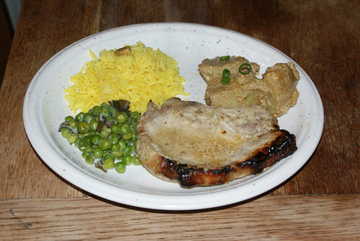
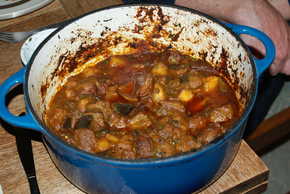

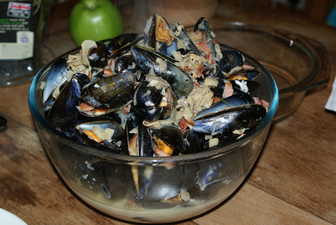
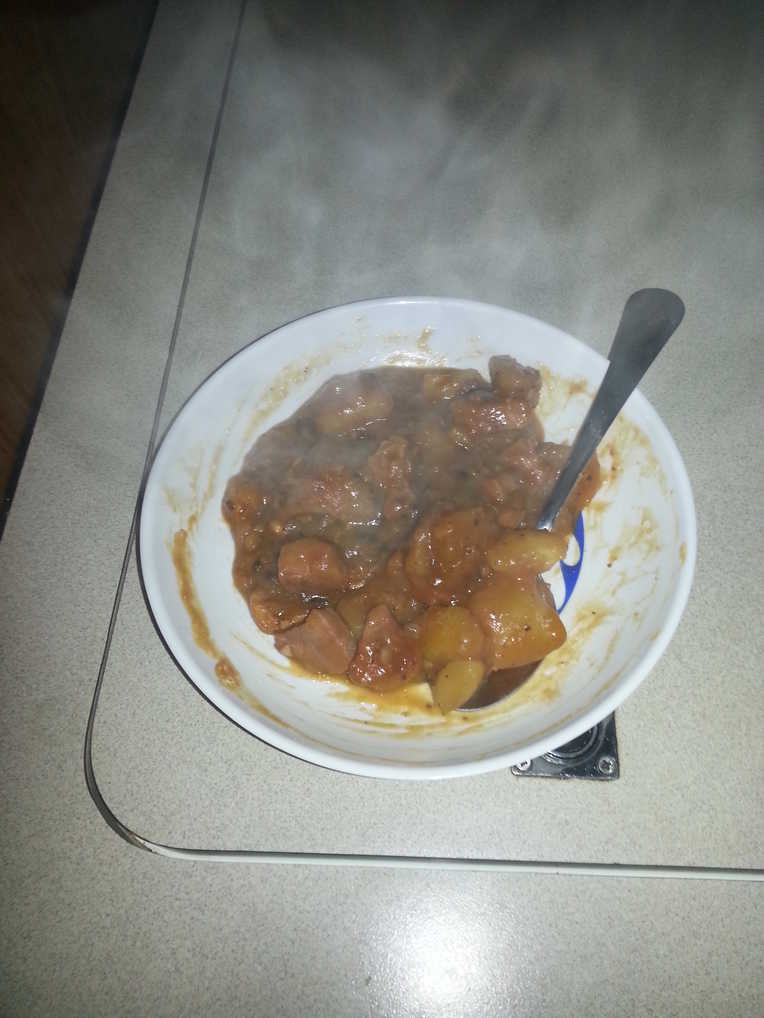
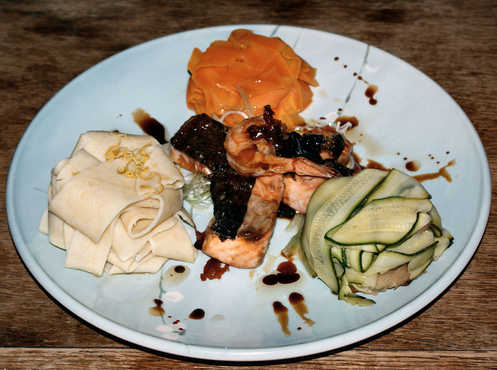
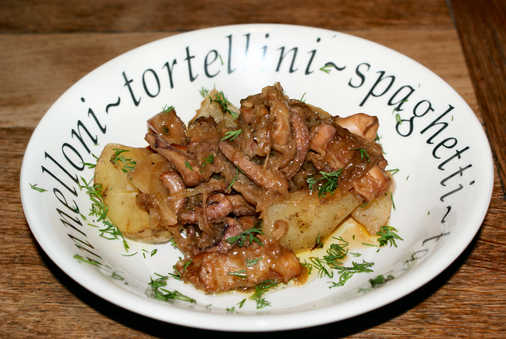
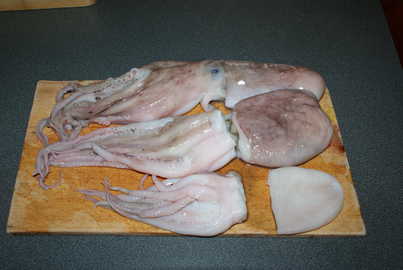
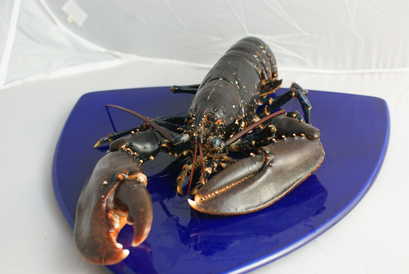
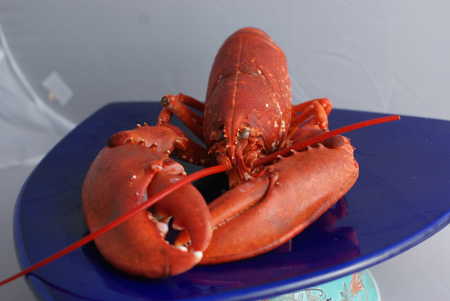
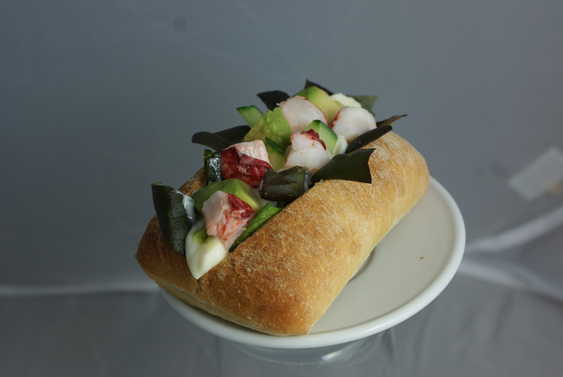
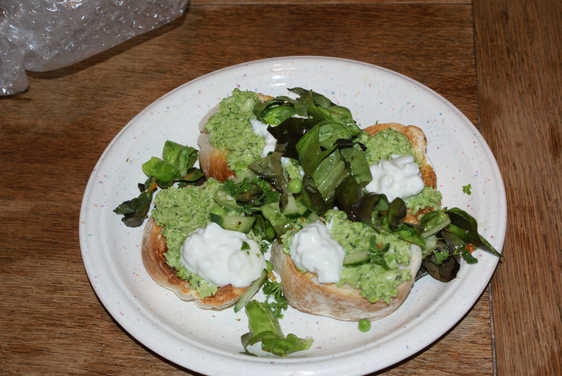
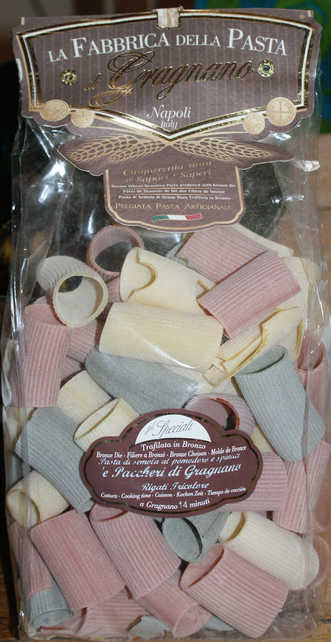
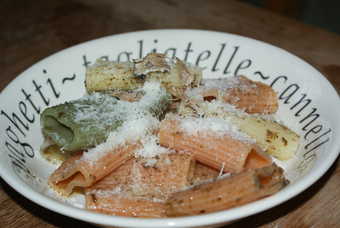
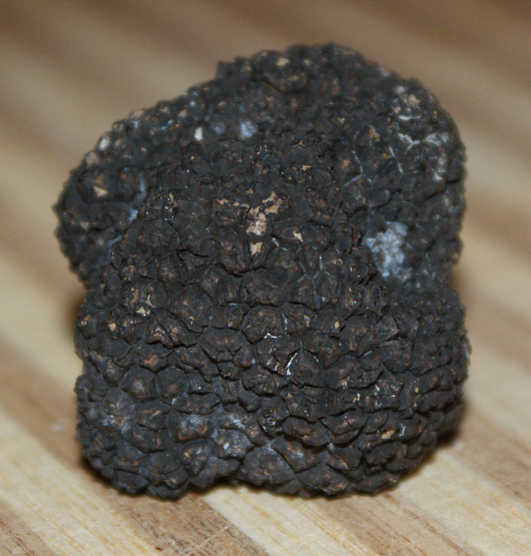
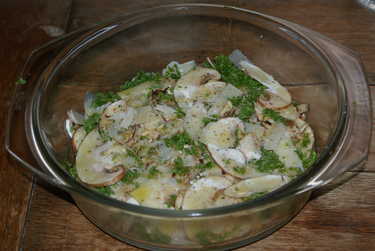
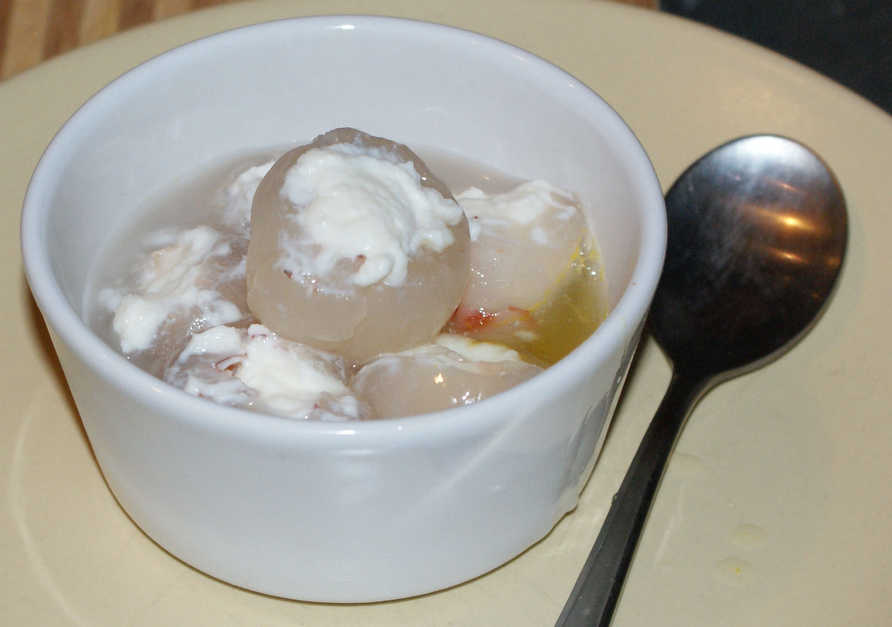

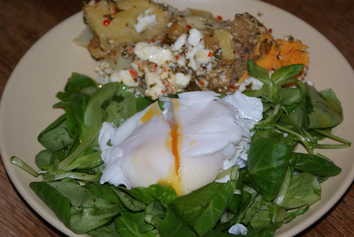

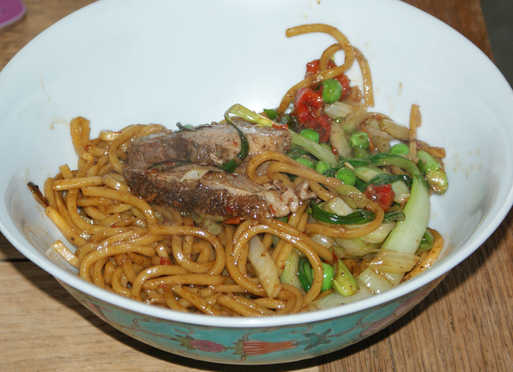
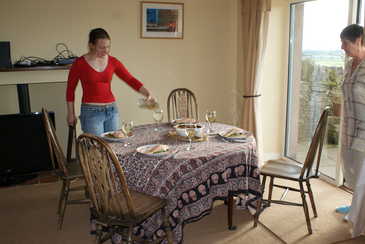

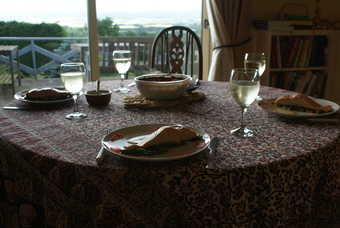
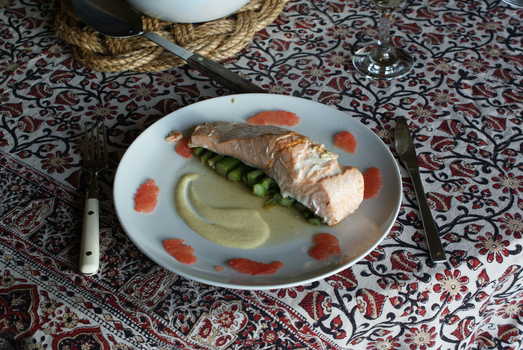
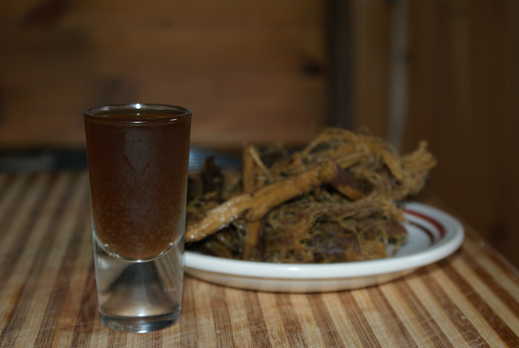
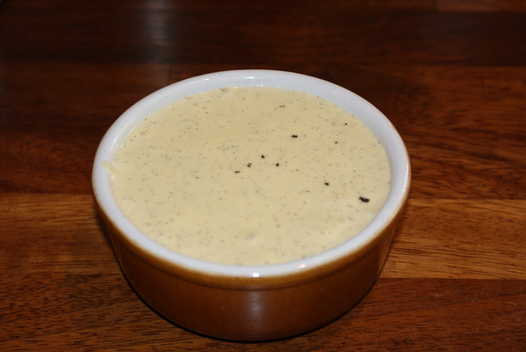
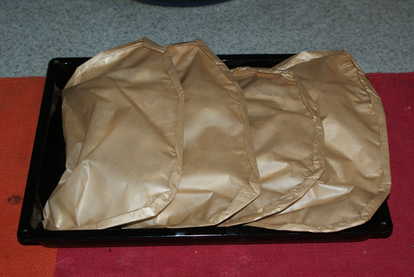

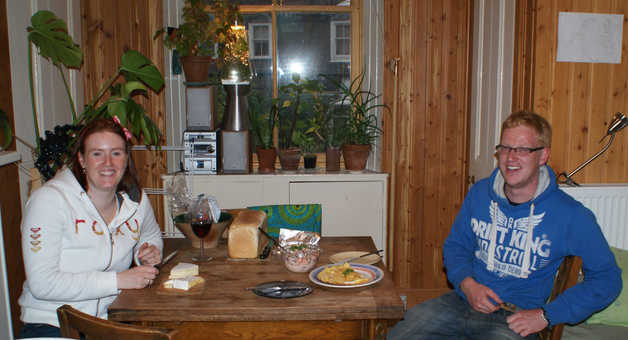
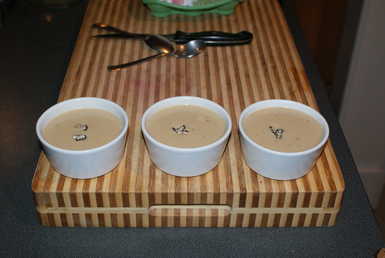
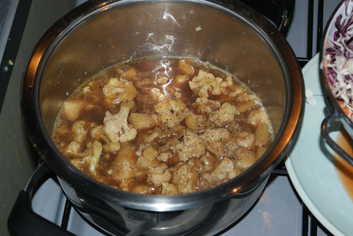
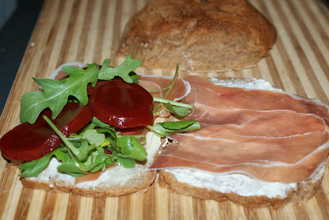
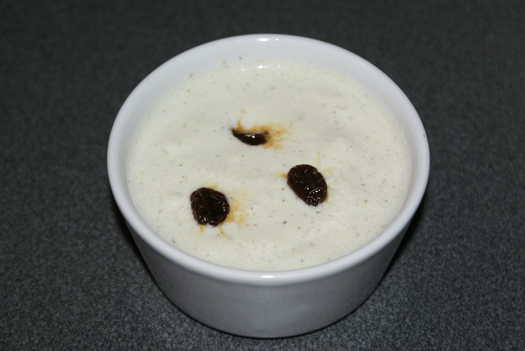
Leave the curry leaves softening in a little water for a while first if you have the time - it will save overcooking the peas.
I think a little grated ginger added just before the peas wouldn't go amiss.